|
Author
|
Message
|
|
glrbird
|
|
|
Group: Forum Members
Last Active: 8 Months Ago
Posts: 616,
Visits: 7.1K
|
Daniel
I have used an air chizel before to rip the bushing from back to front so it wil colapse and just push it out.
Gary Ryan San Antonio.TX.
|
|
|
|
|
lyonroad
|
|
|
Group: Forum Members
Last Active: 10 Years Ago
Posts: 703,
Visits: 3.1K
|
Daniel, I took a small diameter drill bit (can't remember the exact size) and drilled as many holes as I could through the rubber. Eventually I could push enough rubber out that the outer part of the bushing came of. Then you can work on the inner sleeve. I think I used a die grinder ans a small cut off wheel to cut a groove in the inner piece and force it off. Here is how I put the new bushings on. I made a bunch of thick aluminum washers from scrap and disassembled a large three jaw puller. 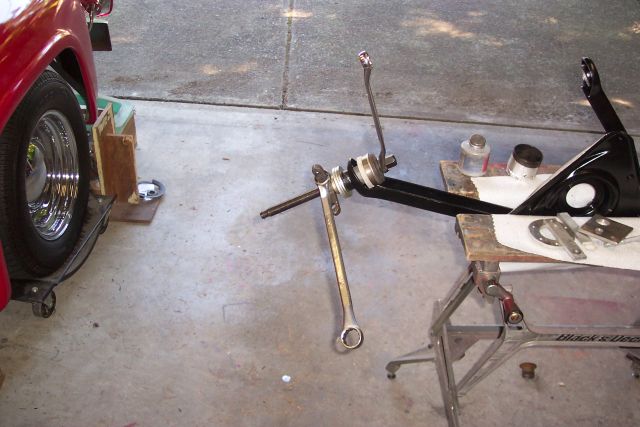 Mark
Mark
1956 Mercury M100
1955 Ford Fairlane Club Sedan
Delta, British Columbia
|
|
|
|
|
Daniel Jessup
|
|
|
Group: Forum Members
Last Active: 6 hours ago
Posts: 2.0K,
Visits: 131.0K
|
|
|
|
|
|
lyonroad
|
|
|
Group: Forum Members
Last Active: 10 Years Ago
Posts: 703,
Visits: 3.1K
|
Daniel Jessup (10/8/2014)
Does anyone know why Ford had to put these shims in the FRONT of the Lower A Arm pivot point? I am wondering if they have anything to do with alignment (like the shims used on the Upper A Arm) or is this just something that Ford used because the crossmembers were never square? I don't think they have anything to do with alignment but I could be wrong on that.... I plan to put them back in because they were there when I disassembled the arm.  Daniel, I am pretty sure they have something to do with the alignment. A few months ago markmontereybay (I think) posted that he was able to increase the caster on his Tbird by moving the shims around. I replaced mine with the horseshoe shaped shims so I can pull them out, put them back or move them around later. Nice looking family. Oops somehow I lost your quote.
Mark
1956 Mercury M100
1955 Ford Fairlane Club Sedan
Delta, British Columbia
|
|
|
|
|
Daniel Jessup
|
|
|
Group: Forum Members
Last Active: 6 hours ago
Posts: 2.0K,
Visits: 131.0K
|
|
|
|
|
|
Daniel Jessup
|
|
|
Group: Forum Members
Last Active: 6 hours ago
Posts: 2.0K,
Visits: 131.0K
|
Spent a few hours today with the trusty sandblaster and the front end. I was surprised at how well my air compressor held up. I didn't blast continuously and would try to let the air compressor "catch up" from time to time, but I was happy with how it did and happy with the results. I also blasted a bellhousing - the pressure pot made QUICK work of that piece and the engine paint turned out nice. I only have about 5 to 6 hours on the pressure pot sandblaster I got from Tractor Supply a while back but I am not impressed with how quickly the "stopper"? is wearing out on the deadman's valve. The sand has worn away the tip on the closer (not just the ceramic tip - that is another story) but the top piece that slides over the tip - that piece is so wore out that the blaster now will leak air when the spring loaded lever is completely closed. I guess it is cheaply made. If there is anyone out there that has any good suggestions on a quality tip/closer I would appreciate it. I am going to look at TP tools. I have one of their Blast Cabinets and have used glass beads for 10 years now. I reckon I have spent countless hours using that gun and have only had to replace the nozzle about 3 times. I know sand is more abrasive, but come on... 6 hours????  Maybe I should take some close up shots of the tip just to show the erosion that has happened pretty quickly. Maybe I should take some close up shots of the tip just to show the erosion that has happened pretty quickly.
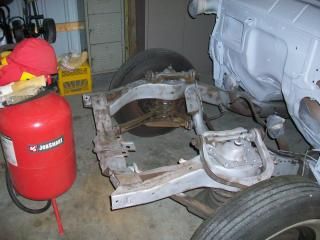 
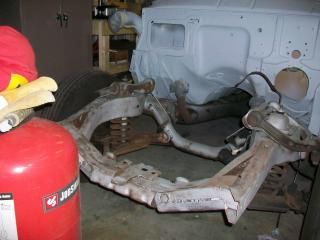 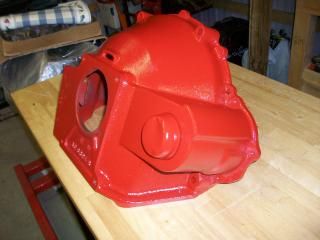
Next up - disassemble the front end so that I can paint the frame and separately blast the pieces in the cabinet. I have new rubber for up front and I have new Aerostar coils as well. I did locate a split sheet metal surround for the steering column and shifter column, and I have started preparing the 56 column and other shifter parts for painting. I also have those hood hinges about ready for topcoat.
If you have been wondering where some of the time goes for projects like these and why it has been a while since my last post, at times my wife gets me side-tracked on things like this.
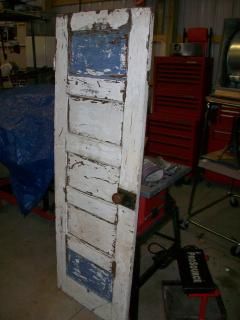
She found this door today at an Apple Harvest Festival about an hour away from us. "It was only $10," she gloated as I unloaded the thing from the van. "Where do you want me to put this?" I asked, knowing what she would say.... "Oh, just put it in the garage, honey."  And so the buffet the garage has been on for the past several months continues. I have never seen a garage hold more crap.... let's see - all the camping gear, outdoor gear, snowtubing and snowboarding toys for the kiddos, gardening supplies (yep - I likes me my peppers, padre!), woodworking tools and table saw, several golf bags, bicycles, fireworks, MY grill/smoker, etc. And my wife laughed when I originally told her we needed a 60x40 instead of a 40x24. What was it she said, "How much room do you need for crying out loud?" And so the buffet the garage has been on for the past several months continues. I have never seen a garage hold more crap.... let's see - all the camping gear, outdoor gear, snowtubing and snowboarding toys for the kiddos, gardening supplies (yep - I likes me my peppers, padre!), woodworking tools and table saw, several golf bags, bicycles, fireworks, MY grill/smoker, etc. And my wife laughed when I originally told her we needed a 60x40 instead of a 40x24. What was it she said, "How much room do you need for crying out loud?"
Maybe I'll just take the latest project she found and put it in the bedroom!  I'm sure that would fly! I'm sure that would fly!
Daniel JessupLancaster, California aka "The Hot Rod Reverend" 
check out the 1955 Ford Fairlane build at www.hotrodreverend.com
|
|
|
|
|
Daniel Jessup
|
|
|
Group: Forum Members
Last Active: 6 hours ago
Posts: 2.0K,
Visits: 131.0K
|
He is supposed to be in to see me this Christmas. For some reason,,,,, I can't reach him on his cell phone????  Daniel Jessup
Daniel JessupLancaster, California aka "The Hot Rod Reverend" 
check out the 1955 Ford Fairlane build at www.hotrodreverend.com
|
|
|
|
|
pegleg
|
|
|
Group: Forum Members
Last Active: 3 Years Ago
Posts: 3.0K,
Visits: 8.7K
|
Dan, Hope he makes it. Subs are tough, I kow something about that. Spent 4 years on a diesel boat (s) in the 60's. If he makes through you can be VERY proud of him.
Frank/RebopBristol, In ( by Elkhart) 
|
|
|
|
|
Daniel Jessup
|
|
|
Group: Forum Members
Last Active: 6 hours ago
Posts: 2.0K,
Visits: 131.0K
|
Been a long time since I posted anything, but to be real honest it has been a long time since I did anything in the shop. This past weekend I did some more blasting after I got my issues with the sandblaster sorted out. Once I changed over to a finer grit (I use that Black Diamond black sand from Tractor Supply Company) we got to cooking with gas. No worries and it went well. I am pretty sure the frame and front end will clean up pretty easily. I did make the mistake that weekend of not priming right away so after a few days flash rust had set in. A little bit of Naval Jelly and the rust dissolved right away. I removed the steering gear and column this morning - the three bolts that hold the gear to the frame were in excellent shape. I have seen pretty rough examples because moisture has a tendency to get trapped up inside there. After that I did some more blasting and prepped for "direct to metal" primer/surfacer. I have used the primer before on some stand alone parts but never on a panel... It sprays very well out of the gun and I like the coverage. The company is called "Tamco" and is based in the Richmond, Virginia area. The white paint for the tutone color is a 66-69 Ford Wimbledon White Mustang SS Urethane from Eastwood (made by Kirker). We will see how that shoots out of the gun. I plan to paint the hood hinges first and see how that goes. I might get the 56 steering column out, clean that up, and then paint that with the WW topcoat also.
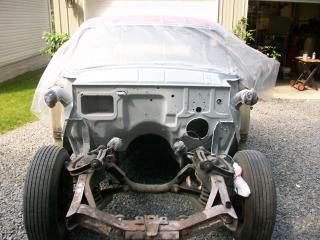 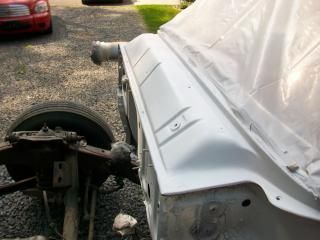
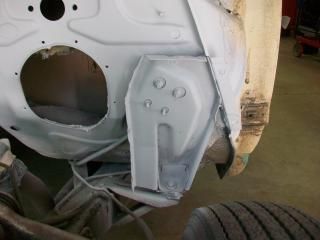 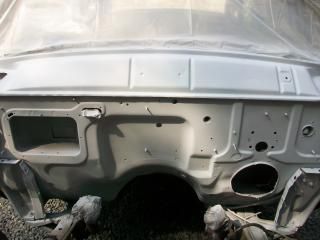
I also had the chance to blast in the cabinet this past week so I got some of the frame pieces finished and linkage rods finished. I also sprayed the Tamco primer on the hood hinges. After doing so much dismantling it feels good to finally have something ready to go back into the car.
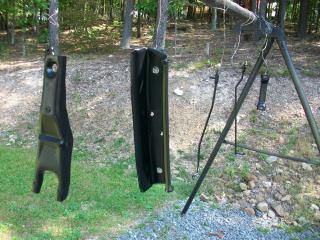
Question: I need to modify the split cover plate that goes around the column and screws to the firewall. My cover plate is obviously for a Fordomatic and not for a manual transmission car. Does anyone have good measurements on where that hole goes and its size? Does anyone have a split cover plate they would "part" with?
Daniel JessupLancaster, California aka "The Hot Rod Reverend" 
check out the 1955 Ford Fairlane build at www.hotrodreverend.com
|
|
|
|
|
Daniel Jessup
|
|
|
Group: Forum Members
Last Active: 6 hours ago
Posts: 2.0K,
Visits: 131.0K
|
Not much done today on the '55... I completed a project that the wife and oldest daughter have been begging me to do - an antique headboard for my daughter's bed. The story goes like this... My parents moved out of an old home that was originally built in the 1850's, had been used as one of the hospitals for Stonewall Jackson's army, etc. In the scrap pile when they bought the place years ago and put stuff into storage was a very old door and 6" trim pieces as shown. When they sold the place and moved out they gave me the old door and trim pieces. "What do I want with these?" I said to them. My parents just smiled at me because they had gone behind my back and talked it up to my wife and oldest daughter about the idea of making a headboard out of this old door. Little did I know! 
Anyhow since it was labor day I had some extra time to examine this thing and get the ball rolling to crank it out and get it done. You can google this idea for more photos on the internet - I am sure there are better ones than mine, but suffice to say I turned the door on its side, trimmed off both sides (what was the top and bottom), MADE CROWN MOLDING OUT OF THE OLD TRIM (please don't ask how that went lol - I finally worked it all out), and then put a piece of trim on the top for a shelf. My wife and daughter were thrilled to say the least and it all passed inspection. Best thing is the girls decided it did NOT need to be painted since the old patina was exactly what they were after. Lancaster, California aka "The Hot Rod Reverend" 
check out the 1955 Ford Fairlane build at www.hotrodreverend.com
|
|
|
|